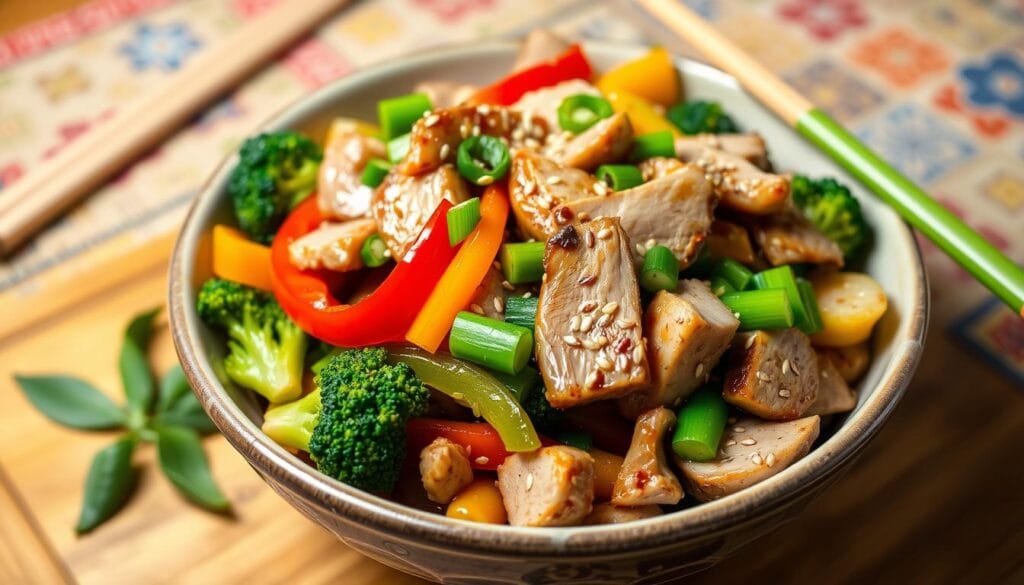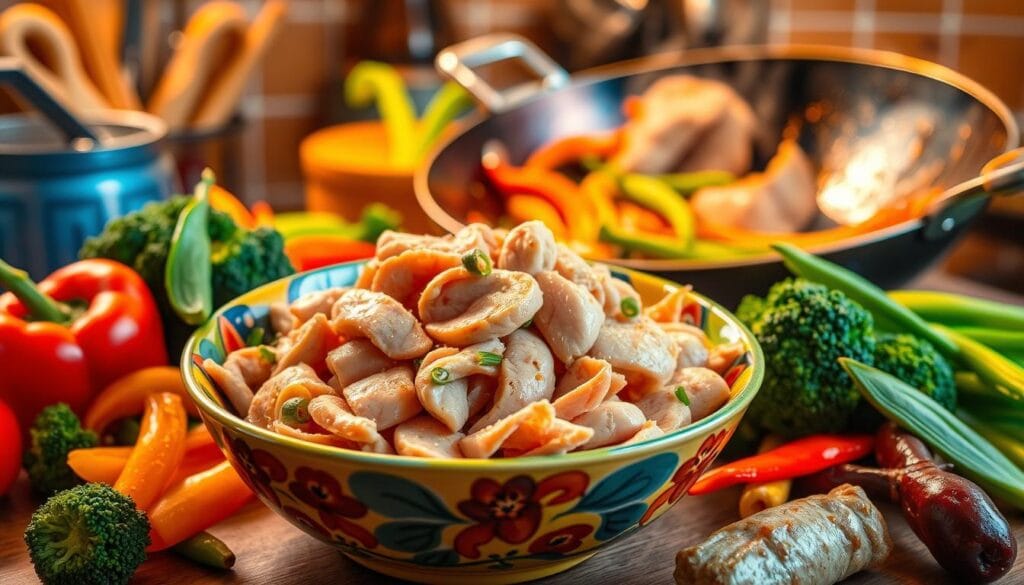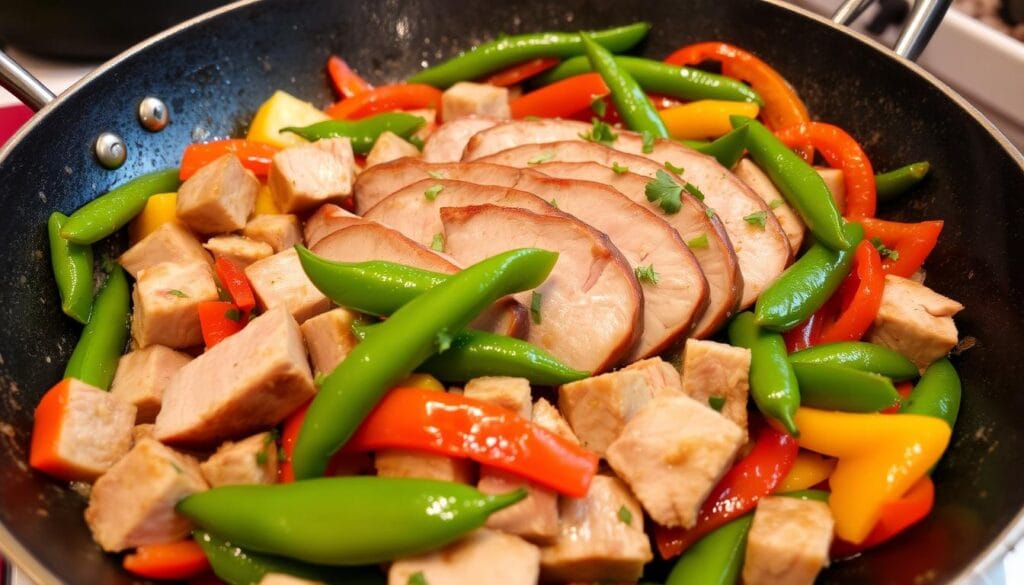
Are you tired of bland weeknight dinners that drain your energy and time? What if I told you that creating a restaurant-quality quick pork stir fry could be easier than ordering takeout?
Easy Asian-inspired dishes like pork stir fry are the ultimate solution for home cooks seeking delicious and efficient weeknight dinner recipes. With just a few simple ingredients and techniques, you can transform ordinary pork into an extraordinary meal that will impress your entire family.
Stir frying is not just a cooking method—it’s an art form that combines speed, flavor, and nutrition in one pan. Whether you’re a busy professional or a home cook looking to expand your culinary skills, these quick pork stir fry recipes will revolutionize your dinner routine.
Key Takeaways
- Pork stir fry takes less than 30 minutes to prepare
- Versatile dish that can be customized with various ingredients
- Affordable and nutritious meal option
- Perfect for beginners and experienced home cooks
- Combines lean protein with fresh vegetables
Understanding the Perfect Pork Stir Fry Basics
Mastering the art of pork stir fry requires understanding key techniques that transform simple ingredients into restaurant-quality meals. Pork tenderloin stands out as the ultimate protein choice for high-heat stir frying, offering lean and tender meat that cooks quickly and absorbs flavors beautifully.

Successful wok cooking relies on several fundamental principles that elevate your culinary skills. Preparation is the cornerstone of an exceptional stir fry experience.
Selecting the Right Cut of Pork
Choosing the perfect cut can make or break your stir fry. Pork tenderloin emerges as the top recommendation due to its:
- Exceptional leanness
- Quick cooking time
- Tender texture
- Ability to absorb marinades
Essential Kitchen Equipment
Effective stir frying demands specific tools that support high-heat cooking techniques:
| Equipment | Purpose |
|---|---|
| Wok or Large Skillet | Enables even heat distribution |
| Sharp Chef’s Knife | Precise meat and vegetable cutting |
| Wooden Spatula | Prevents scratching cooking surface |
Basic Stir Fry Techniques
Wok cooking requires specific techniques to achieve perfect results:
- Prep ingredients before heating pan
- Use high heat consistently
- Keep ingredients moving
- Cook in small batches
“The secret to great stir fry is high heat and constant motion.” – Professional Chef
By understanding these fundamental principles of high-heat stir frying, you’ll transform ordinary ingredients into extraordinary meals that tantalize taste buds and impress dinner guests.
Best Cuts of Pork for Stir-Frying Success

Selecting the right cut of pork can make or break your stir-fry experience. Pork tenderloin stands out as the ultimate champion for creating delicious and tender stir-fry dishes. This lean pork cut offers exceptional qualities that home cooks and professional chefs alike appreciate.
When searching for the perfect tender pork for stir fry, focus on these key characteristics:
- Minimal fat content
- Soft, delicate muscle texture
- Quick cooking time
- Easy to slice thinly
Pro Tip: Pork tenderloin provides an impressive nutritional profile. A 3-ounce serving delivers 25 grams of protein while containing only 6 grams of fat, making it an excellent choice for health-conscious meal preparation.
“The secret to a perfect stir-fry lies in selecting the right cut of meat” – Professional Chef’s Wisdom
Beyond pork tenderloin, boneless pork chops can serve as alternative lean pork cuts for stir-frying. Avoid fatty cuts like pork shoulder, which are better suited for slow-cooking methods.
Slicing Techniques for Maximum Tenderness
- Slice meat against the grain
- Cut into thin, uniform pieces
- Partially freeze meat for easier slicing
- Aim for consistent 1/4-inch thick slices
With these guidelines, you’ll transform your stir-fry from ordinary to extraordinary, ensuring each bite is packed with flavor and tender perfection.
Essential Ingredients for Authentic Asian Flavors
Creating a delicious pork stir fry relies on selecting the right ingredients that bring depth and complexity to your dish. The magic of Asian cuisine lies in its carefully balanced flavors and aromatic components.
Traditional Asian Sauces and Seasonings
The foundation of any great stir fry starts with exceptional sauces. Reduced-sodium soy sauce provides a rich umami base, while sriracha adds a spicy kick to elevate the dish’s flavor profile.
- Light soy sauce for seasoning
- Dark soy sauce for color and depth
- Sriracha for heat
- Sesame oil for finishing
Fresh Aromatics and Spices
Fresh garlic and ginger are crucial ingredients that transform an ordinary meal into an extraordinary culinary experience. These aromatics create a robust flavor foundation for your stir fry.
| Aromatic | Flavor Profile | Preparation |
|---|---|---|
| Garlic | Pungent and sharp | Minced or crushed |
| Ginger | Warm and slightly spicy | Grated or finely chopped |
Vegetable Combinations
Asian vegetables play a critical role in creating texture and nutrition in your stir fry. Select a vibrant mix of vegetables to complement the pork and enhance the overall dish.
“The secret to an amazing stir fry is balancing flavors and textures.” – Professional Chef
- Broccoli
- Bell peppers
- Snap peas
- Carrots
- Red onions
By combining these essential ingredients, you’ll create a restaurant-quality stir fry that bursts with authentic Asian flavors right in your own kitchen.
Quick and Easy Pork Stir Fry Meat Recipes
Dive into the world of 30-minute meals with these versatile stir fry dishes that transform pork tenderloin into a delectable culinary experience. Easy pork recipes are all about creating maximum flavor with minimal effort.
“Cooking should be quick, enjoyable, and delicious!” – Professional Chef’s Wisdom
Pork tenderloin stands out as the ultimate protein for stir fry recipes. Its remarkable tenderness and lean profile make it perfect for fast-paced cooking techniques.
- Ideal cooking temperature: 145°F for optimal tenderness
- Typical cooking time: 4-5 minutes for initial meat preparation
- Total recipe time: Around 27 minutes
The magic of these easy pork recipes lies in the perfect sauce combination. Blend teriyaki, low-sodium soy sauce, hoisin, garlic, ginger, and a touch of chili paste to elevate your stir fry game.
| Ingredient | Quantity | Nutritional Impact |
|---|---|---|
| Pork Tenderloin | 1 lb | 30g Protein |
| Mixed Vegetables | 2 cups | Low Calorie, High Fiber |
| Stir Fry Sauce | 1/4 cup | Rich Flavor Profile |
Pro tip: Prepare all ingredients before cooking to streamline your stir fry process and create restaurant-quality dishes at home.
Vegetable selections like zucchini, bok choy, mushrooms, and snap peas can transform your versatile stir fry dishes. Mix and match based on seasonal availability and personal preference.
With an average preparation time of just 27 minutes, these 30-minute meals offer a perfect solution for busy home cooks seeking nutritious and delicious dinner options.
Creating the Perfect Stir Fry Sauce
Crafting a delicious homemade stir fry sauce is an art that transforms ordinary meals into extraordinary culinary experiences. The right sauce can elevate your pork stir fry from simple to sensational, bringing depth and complexity to every bite.
A great soy-based sauce requires careful balance and understanding of flavor profiles. Home cooks can create restaurant-quality sauces with just a few key ingredients.
Classic Soy-Based Sauce Foundation
The perfect base for a homemade stir fry sauce combines several essential components:
- 1/2 cup reduced-sodium soy sauce
- 1/2 cup reduced-sodium chicken broth
- 1-2 tablespoons cornstarch
- 1 tablespoon minced garlic
- 1 tablespoon brown sugar
Spicy Asian Sauce Variations
For those who enjoy a kick, transform your basic sauce into a spicy Asian sauce by adding:
- 1-2 teaspoons sriracha
- 1/2 teaspoon red pepper flakes
- 1 teaspoon chili oil
Sweet and Tangy Flavor Profiles
Experiment with ingredients to create unique sauce variations:
| Ingredient | Quantity | Flavor Impact |
|---|---|---|
| Rice Vinegar | 1 tablespoon | Adds tanginess |
| Hoisin Sauce | 2 tablespoons | Creates sweetness |
| Sesame Oil | 1/2 teaspoon | Provides depth |
“The secret to an amazing stir fry is balancing flavors and creating a sauce that complements your ingredients.” – Professional Chef
Nutrition tip: A typical homemade stir fry sauce contains approximately 80 calories per serving, with 8g carbohydrates and 3g protein. Adjust ingredients to match your dietary needs.
Tips for Achieving Restaurant-Quality Results
Mastering professional stir fry techniques requires more than just throwing ingredients into a pan. The secret to creating restaurant-quality meals lies in understanding the nuanced art of cooking at high heat and maintaining precise control over your ingredients.
“Wok hei is the soul of stir-frying – it’s about capturing that perfect smoky essence that elevates a simple dish to culinary art.”
Professional chefs know that preparation is key to successful stir-frying. Here are critical cooking tips to transform your home cooking:
- Prep all ingredients before heating the wok
- Use high heat to create authentic wok hei flavor
- Keep ingredients moving constantly
- Cook meat and vegetables separately
The velveting technique stands out as a professional stir fry technique that dramatically improves meat texture. By coating pork in a mixture of cornstarch, egg white, and seasonings, you’ll achieve that silky, tender result found in top-tier restaurants.
| Technique | Purpose | Key Benefit |
|---|---|---|
| Velveting | Tenderize meat | Prevents moisture loss |
| High Heat Cooking | Create wok hei | Develops complex flavors |
| Separate Cooking | Maintain ingredient integrity | Preserves individual textures |
Remember, achieving that perfect stir-fry is about understanding heat, timing, and ingredient interaction. With practice, you’ll transform your home cooking into a professional culinary experience.
Vegetable Pairings and Combinations
Creating the perfect stir fry is an art of balancing flavors and textures through strategic vegetable combinations. Stir fry vegetables play a crucial role in transforming a simple dish into a vibrant, nutritious meal that delights both the palate and the eye.
Fresh vs Frozen Vegetables: Choosing Your Ingredients
When preparing stir fry vegetables, you have two primary options: fresh or frozen. Fresh vegetables offer crisp textures and bright colors, while frozen alternatives provide convenience without sacrificing nutrition.
- Fresh vegetable advantages:
- Crisp texture
- Vibrant colors
- Maximum nutrient retention
- Frozen vegetable benefits:
- Year-round availability
- Quick preparation
- Consistent quality
Seasonal Produce for Dynamic Vegetable Combinations
Embracing seasonal produce ensures your stir fry remains exciting and nutritionally diverse throughout the year. Different seasons bring unique vegetable combinations that can elevate your cooking.
| Season | Recommended Stir Fry Vegetables |
|---|---|
| Spring | Asparagus, snap peas, baby carrots |
| Summer | Bell peppers, zucchini, cherry tomatoes |
| Autumn | Brussels sprouts, butternut squash, mushrooms |
| Winter | Kale, cauliflower, root vegetables |
“The secret to an amazing stir fry lies in selecting the right vegetable combinations that complement each other in flavor and texture.”
When selecting stir fry vegetables, aim for a mix of colors, textures, and nutritional profiles. Experiment with different seasonal produce to keep your meals exciting and nutritionally balanced.
Serving Suggestions and Side Dishes
Elevate your pork stir fry experience with perfect rice pairings and noodle options that complement the rich flavors of your dish. The right accompaniment can transform a simple meal into a culinary adventure.
- Classic steamed white rice
- Nutty brown rice for added nutrition
- Cauliflower rice for low-carb alternatives
- Fragrant jasmine rice
For those seeking low-carb alternatives, zucchini noodles (zoodles) or lettuce cups provide excellent options. Crisp lettuce wraps can add a refreshing crunch to your spicy pork stir fry.
Noodle options are equally exciting for your meal:
- Udon noodles for a thick, chewy texture
- Lo mein noodles for classic Asian flavor
- Rice noodles for a lighter option
“The right side dish can elevate a good meal to an extraordinary dining experience.” – Chef’s Wisdom
Consider complementing your pork stir fry with these side dishes:
- Egg drop soup
- Crispy spring rolls
- Asian-inspired cucumber salad
Garnish your dish with chopped green onions, fresh cilantro, or crushed peanuts to add an extra layer of flavor and texture. These final touches can transform your stir fry from simple to spectacular.
Conclusion
Pork stir fry represents an incredible culinary adventure for home cooks seeking quick Asian-inspired meals. These dishes offer remarkable flexibility, allowing you to transform simple ingredients into restaurant-quality dinners in under 30 minutes. By understanding core techniques like maintaining high heat, balancing ingredient ratios, and selecting complementary vegetables, anyone can create delicious and nutritious meals.
The magic of healthy stir fry options lies in their adaptability. Ground pork provides an affordable protein base that can be easily customized with various seasonings like soy sauce, rice vinegar, and fresh herbs. Whether you prefer spicy chili garlic sauce or a sweet honey glaze, these versatile pork dishes can be tailored to suit individual taste preferences and dietary needs.
Kitchen experimentation becomes enjoyable when you embrace the fundamental principles of stir frying. A balanced 1:1 or 2:1 ratio of meat to vegetables ensures a nutritious meal, while techniques like searing meat first and adding vegetables strategically help maintain optimal texture and flavor. With practice, you’ll develop confidence in creating vibrant, satisfying stir fries that impress family and friends.
Ultimately, mastering pork stir fry is about creativity, technique, and passion for cooking. Embrace the journey, explore different flavor profiles, and enjoy the delicious results of your culinary skills.
FAQ
What is the best cut of pork for stir fry?
Pork tenderloin is the ideal cut for stir-frying due to its leanness and tenderness. It cooks quickly and remains juicy when sliced thinly. Boneless pork chops can also be used as an alternative. Avoid fatty cuts like pork shoulder, which are better suited for slow cooking methods.
How long does it take to make a pork stir fry?
A typical pork stir fry can be prepared in under 30 minutes, making it perfect for quick weeknight dinners. The process involves preparing ingredients, cooking the meat, stir-frying vegetables, and creating a sauce – all of which can be completed relatively quickly.
What essential equipment do I need for making a pork stir fry?
You’ll need a large skillet or wok and a sharp knife for slicing meat and vegetables. The key is to have a pan that can handle high heat and allow for quick, even cooking of ingredients.
What are some key ingredients for an authentic Asian-style pork stir fry?
Essential ingredients include reduced-sodium soy sauce, sriracha, fresh garlic, ginger, and a variety of vegetables like broccoli, bell peppers, snap peas, and carrots. Sesame oil and sesame seeds are great for finishing touches.
How do I create the perfect stir fry sauce?
A classic stir fry sauce combines soy sauce, water, garlic, honey, and cornstarch. For variety, you can add sriracha for heat, rice vinegar for tanginess, or hoisin sauce for sweetness. The key is to create a sauce that’s thick enough to coat the meat and vegetables.
What are some serving suggestions for pork stir fry?
Traditionally, pork stir fry is served over steamed white rice or noodles like hokkien or udon. Healthier options include brown rice, cauliflower rice, or zucchini noodles. You can also serve it in lettuce cups for a low-carb alternative.
How can I achieve restaurant-quality stir fry at home?
Use high heat to create wok hei (smoky flavor), prep all ingredients before cooking, don’t overcrowd the pan, and cook meat and vegetables separately. Use cornstarch to velvet the meat for a professional touch, ensuring tender and flavorful results.
Can I use frozen vegetables in my stir fry?
While fresh vegetables are ideal, frozen vegetables can be used for convenience. Keep in mind that frozen vegetables may release more water during cooking, which can affect the overall texture of the dish.
How do I ensure the pork stays tender when stir-frying?
Slice the pork against the grain and consider partially freezing it to make slicing easier. Cook quickly over high heat and avoid overcooking. Using cornstarch to coat the meat before cooking can help keep it tender and create a velvety texture.
Are there any low-carb alternatives for serving pork stir fry?
Yes! Try serving your pork stir fry in lettuce cups, over cauliflower rice, or with zucchini noodles as low-carb alternatives to traditional rice or wheat noodles.

